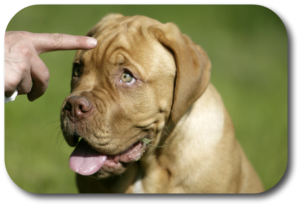Many of our clients tell us that they are never quite sure when and how to correct their dog. If they see he is about to do something, should they correct him? If they come home and he has destroyed something, should they correct him?

The timing of your dog’s correction is critical in the communication and education process. As opposed to us, dogs live in the “here and now”. For the most part, the past is the past, water under the bridge, spilled milk, etc. Your dog focuses is on the sights and sounds of the present. Correcting him for something he has done in the past is irrelevant and only leads to his confusion.
You and I understand the idea of “consequences of our actions”. This means that we comprehend when we are corrected for something we did in the past. Your dog does not. He only understands what is happening right now. This relates to what he is doing and how you are responding. Here are some points you should think about:
- Only correct your dog if he is doing the bad thing right now. If he is jumping on you, barking at the back door, on the furniture; correct him right now. You are communicating to him that what he is doing RIGHT NOW is wrong. Since your dog lives in the RIGHT NOW, he will understand and learn from your correction.
- You can be proactive and if your dog is about to do something wrong, correct him now. This is a page from our Mother’s playbook of “Don’t even think about it!”. Your dog is already thinking of doing the bad thing, so you are really still correcting him in the moment. Although his action hasn’t taken place yet, his intention of performing the action is in the hear and now.
- Do not make the classic mistake of correcting your dog if he already did something bad and is not doing it now. Your dog will mistakenly think your correction is for what he IS doing and not what (your intention) he WAS doing.
I completely understand that you can get really upset at your dog when he did something while you were away and you have come home to find it. You either have to adjust the environment of your home so that he can’t do that bad thing while you are away or you will just have to understand that you must “live with it”. Life is always about trade-offs.
So you now understand the concept of “correcting your dog in the present”. You also need to understand the physical nature of your correction. First of all, “physical” does not mean you are going to hit, frighten, or scare your dog. That is the last thing you want to do. When your dog is scared, he has lost the ability to learn. Correction is about effective learning and not scaring. Here are some guidelines to review:
- Dogs mainly communicate through body language. When you correct, remain calm and stand tall. This sends a passive signal to your dog that he needs to give you focus. Your stoic nature will indicate that you mean him no harm and have no intention of aggressively escalating the situation.
- Correct using the same methodology every time. Besides your body language, you will need to use your voice to create a unique “focus on me” sound. Think of the old west when the cook rings the dinner bell.
- Be consistent and repetitive when you correct. If you don’t want him to jump, you must correct him every times he jumps. Your dog must understand “I just can’t do this” for your correction to be effective.
- Tune your correction with your dog’s temperament. Some dogs are more flighty than others. Some dogs are really hard headed. You goal is to get your dog’s calm and respectful focus. You must engage enough stimulus to achieve that without going overboard and scaring them. The amount of stimulus you need is different for every dog.
Please call Robin or me at (770) 718-7704 if you need any dog training help. We are blessed to have been your local dog training professionals for over fifteen years. We have trained over 5,000 great dogs and loving families and are ready to help you.

Follow Us!